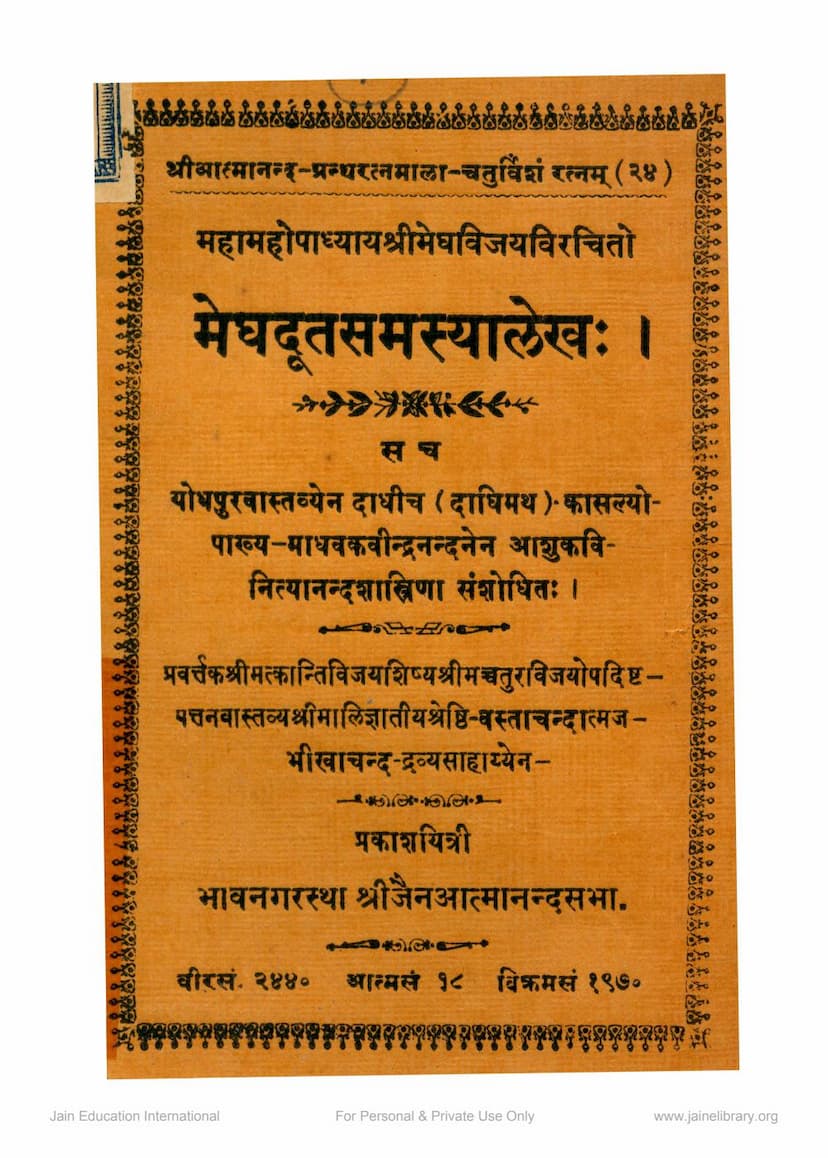Meghdut Samasyalekh
Added to library: September 2, 2025

Summary
Here's a comprehensive summary of the Jain text "Meghaduta Samasyalekha" by Meghvijay, based on the provided pages:
Book Title: Meghaduta Samasyalekha (मेघदूतसमस्यालेखः) Author: Mahamahopadhyaya Shri Meghvijay (महोपाध्याय श्रीमेघविजय) Publisher: Shri Jaina Atmanand Sabha, Bhavnagar (भावानगरस्था श्रीजनआत्मानन्दसभा)
Overview:
"Meghaduta Samasyalekha" is a poetic work by the esteemed Jain scholar and poet Meghvijay. The title itself indicates its connection to Kalidasa's famous Sanskrit poem, the Meghaduta (Cloud Messenger). This work is a "samasyapurti" or "samasyalekha," meaning it is a poem composed to fulfill a specific poetic problem or constraint. In this case, it is likely a response to or continuation of themes found in the Meghaduta, possibly with a Jain philosophical and devotional perspective.
Author and Context:
The preface identifies Meghvijay as a disciple of Shri Krp Vijay, who was a disciple of Shri Hirvijay Surishwar, a prominent figure in the Tapagachchha lineage. The text further states that Meghvijay also composed a samasyapurti for the Magha's Magha Mahakavya. The manuscript was reportedly completed in the Vikram Samvat year 1727 (corresponding to 1670 CE) in Sadadi. The preface also mentions that the original manuscript was found in the Sagaragachchha library in Patan and was subsequently revised and annotated by Ashukavi Nityanand Shastri of Jodhpur. The publication was made possible by the financial assistance of Bhikhachand, son of Vasta Chand, a businessman from Patan, and was overseen by Shri Chaturvijay.
Content and Themes:
The text is a samasyapurti poem, which means it is structured around a specific poetic challenge. While the exact nature of the "samasyā" (problem) isn't explicitly detailed in the provided pages, the content of the poem itself gives us strong clues.
The poem narrates the journey of a cloud messenger, similar to Kalidasa's Meghaduta. The narrative begins with the cloud (Megha) receiving a message from a yogi who is separated from his spiritual guru, Shri Vijayprabh Surishwar. The yogi, in the month of Bhadra, sees a cloud and decides to use it as a messenger.
The poem then proceeds to describe various locations, natural scenes, and religious figures, all seen through the perspective of the cloud's journey. Key elements that emerge from the verses include:
- The Cloud as a Messenger: The central theme is the cloud's role in carrying messages and serving as a link between individuals, likely representing the guru-disciple relationship or spiritual guidance.
- Devotional Odes to Jain Tirthankaras: A significant portion of the poem (starting from page 7) is dedicated to describing the virtues and glories of Jain Tirthankaras, particularly Lord Shantinath (pages 7-9), and other prominent Jain deities and figures. These descriptions often involve elaborate imagery of their divine attributes, celestial processions, and the miracles associated with them.
- Descriptions of Geographical Locations: The poem vividly describes various places as the cloud travels. These include:
- Ramgiri Ashram: The initial location where the yogi resides.
- Devpatan: The destination city, where the guru resides.
- Avaragava (Page 12): The poem describes Avaragava with its beautiful gardens, palaces, and engaged citizens.
- Devgiri (Page 13): A significant location, described with historical and religious associations.
- Various Cities and Regions: The poem mentions other locations, hinting at a widespread geographical journey across India, encompassing places like Malwa, Dasapura, Bhrugu-pura, and Saurashtra.
- Jain Practices and Philosophy: The verses allude to Jain practices such as prayers, rituals, devotion to the guru, the importance of knowledge and conduct, and the cyclical nature of existence. The descriptions of the Tirthankaras emphasize their role as liberators from worldly suffering.
- Poetic Artistry: The poem is written in Mandakranta meter, a classical Sanskrit meter known for its flowing and melodic quality. The language is rich in Sanskritized Gujarati, displaying a high level of poetic skill and erudition. The descriptions are replete with metaphors, similes, and elaborate imagery, characteristic of classical Indian poetry.
- The Guru-Disciple Relationship: The poem consistently emphasizes the reverence and importance of the guru, with the cloud being instructed to seek blessings and convey messages to the spiritual master.
Overall Significance:
"Meghaduta Samasyalekha" is a significant work within Jain literature, showcasing the fusion of classical poetic traditions with Jain devotional and philosophical themes. It demonstrates how ancient literary forms can be adapted to convey profound spiritual messages and extol the virtues of Jain Tirthankaras and spiritual preceptors. The poem serves as a testament to the literary prowess of Meghvijay and the rich cultural heritage of Jainism.